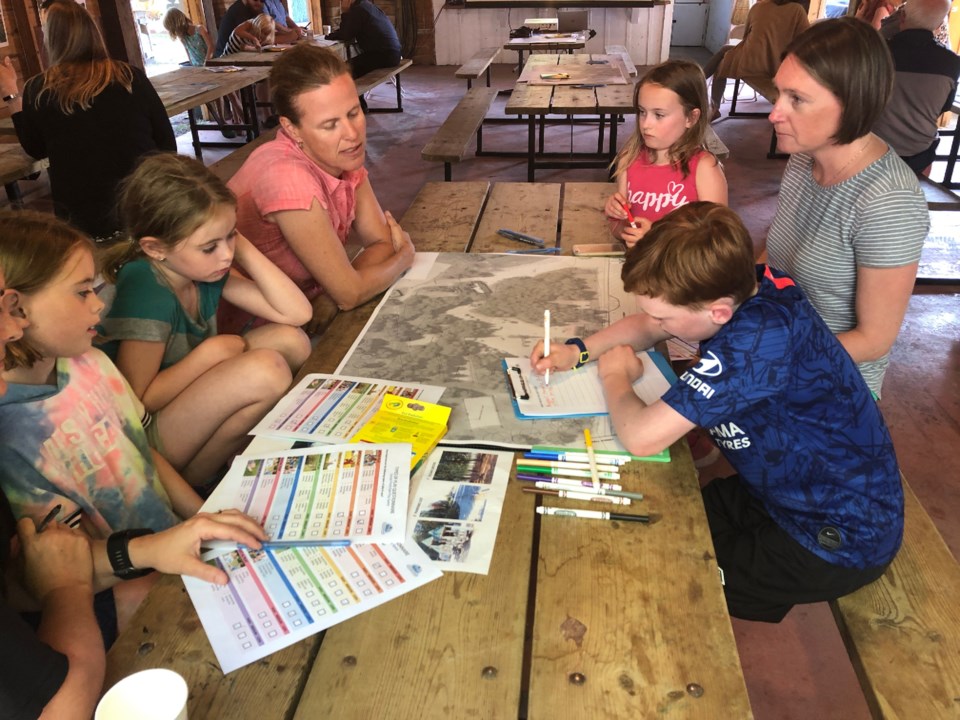Brainstorming continues for a new park at Sunset Point, and some of the suggestions are surprising the consultants - particularly some of the kids’ affinities for pits.
“We’ve had suggestions for water balloon pits, ball pits, foam pits,” said David Wood, president of Envision Tatham, the firm leading the consultation process for the new playground. “What’s really surprising is how interested everyone is in colour … they want lots of colour.”
Wood was at Sunset Park last night with members of his staff and some from the town’s Parks, Recreation and Culture Department, leading a family engagement and brainstorming session.
About 10 people (adults and children) were at the presentation.
Edward Rowe, a Sunset Point resident who has been critical of the town’s decision not to release raw data from an online survey done in the spring, attended the meeting. He stated again he wanted to see the results of the survey now.
He said he was weary of hearing something would be built but no shovels have been in the ground yet.
“This should have been built last year,” said Rowe. “People should be outraged.”
Director of Parks, Recreation, and Culture, Dean Collver, stepped in to respond.
He said the results of the survey and suggestions put forward by residents in the survey would be included in the staff report to council.
According to a letter supplied to Rowe by the town, that report will be completed and delivered, publicly, to council within the next 120 days.
Another resident at the session said it would be nice to hear the ideas other residents put forward in order to build on them.
Wood said he and his team are quantifying results from the survey and from five other public sessions as that information comes in.
They’ll be using all the input to create design objectives, and those will be given to the firm hired to design the custom playground equipment.
Collver said the project is unique, not only because it will be custom-designed play equipment, but because it will be designed based on input received from kids and adults in the community.
“The designer … will know what’s important to people,” said Collver. “They will be receiving all of this information.”
At the session, Wood asked those present to come up with ideas and suggestions for structures or spaces in the playground that will serve seven different types of play, including active play (gross motor skills, physical actions), artistic play (self-expression), creative play (creating something), sensory play (engaging all five senses), games play (anything that requires rules and friends), social play (sharing, cooperating), and reflective play (quite spots).
According to Wood, in engagement sessions thus far with both children and adults, he was interested to see how equally all seven types of play were valued.
If it were a pie chart, he expected active play to occupy most of the circle, and while it’s still the larger slice, he said the pie is more evenly balanced.
“That could indicate a lot of types of play are underserviced,” he said. “It’s interesting to see kids respond with a balanced set of needs.”
Of course, imagination runs wild when Wood and his team ask elementary-aged children to plan the park of their dreams.
One young boy, rather excitedly, showed his plan for an elaborate maze made from elevated beams, and a red, multi-textured “floor” underneath. The floor would, of course, be lava, and the objective would be to cross the maze without stepping in the lava.
A group of young girls planned a “pet” area where they could leave their pets while they played. A small circle for pets like gerbils grew to also include a stable for their horses.
While a horse stable might be a stretch, kids are also bringing ideas like a tug-of-war rope set up, colourful basketball courts, and capture the flag fields.
In another session this week Wood and his team will be asking youth who grew up with cognitive and physical disabilities about the kinds of barriers they faced, and how a new park might give younger kids with similar disabilities a way to play barrier-free.
The current playground, built about 27 years ago, is called the EnviroPark, and each structure was designed to represent a part of Collingwood from town hall, to downtown businesses, a typical home, and the water treatment plant. It is one of Collingwood’s largest parks, and certainly the largest playground area.
“A lot of thought went into this playground back in the day,” said Wood. “I want to make sure we’re putting that same thought into a new design.”
Soon the town will put out a request for proposal document seeking custom playground designers to put together a design for a park based on the results of public engagement sessions and written submissions.
No construction schedule has been set for the project.
For more on the status of the Sunset Point Park design and build, click here. You can submit feedback or suggestions in writing by emailing Amanda Norris at [email protected].
